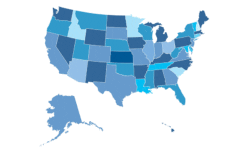Gangs and Our Children
Community gang prevention programs help keep our children away from the gang lifestyle.
A group of three or more people with a common name who engage in criminal activity is the generally accepted definition of a gang. There’s no such thing as a good gang, because all gangs are composed of criminals who commit crimes such as vandalism, conspiracy to murder, and much more.
Of course, all gang members have enemies who don’t hesitate to hurt or kill them and anyone that gets in their way, including loved ones.
Related Article:Gang Prevention 101: A School Approach
In Los Angeles, 1,100 street gangs and their 150,000 members commit an average of one gang-related killing and 10 drive-by shootings per day. In my Santa Barbara County, we don’t have that level of violence. But this county is also being impacted by its local gangs and their evolving rivalries, which have resulted in the killing of many perceived enemies and the arrest, prosecution, and incarceration of their killers.
The number of local gang killings is low, and it’s our common belief that one is too many. Whenever one of our children becomes a victim of gangs, it affects all of us. Specifically, when we personalize this problem and perceive the murdered child as a part of our family, it wounds our existence forever.
With this in mind, the South Coast Task Force on Youth Gangs was established to develop effective gang prevention, intervention, and suppression initiatives to serve and protect the lives of our children, youth and families.
Gang prevention targets children and youth attending local schools who are at risk of joining gangs. Prevention includes teaching children character education to clarify the basic definitions of respect, responsibility, honesty, integrity, empathy, and loyalty. Prevention education also covers the definition of a gang, choices and consequences, refusal skills, conflict management, and how to achieve success outside of gangs.
Best practices in this arena include the evidence-based Gang Resistance Is Paramount Program (GRIP). This program offers a curriculum of 15 gang prevention lessons for students in elementary and secondary schools. Each 50-minute lesson can be taught by trained teachers or community facilitators. Based on current evaluations of this program, over 80 percent of students who participate in its educational and recreational activities stay out of gangs. The success of the program deserves attention and replication at local needy schools.
Gang intervention focuses on addressing the diverse needs of gang-involved youth and persuading them to make a commitment to replace their gang thinking and behavior with healthy alternatives. An important goal of this work is to help youth get out of gangs and ultimately become former gang members.
Leaving a gang isn’t easy. Many gangs believe in “blood in, blood out,” which makes the price of getting out deadly. Similarly, because enemy gang members believe that enemies are forever, expecting these individuals to agree to label an enemy as a friend can be unrealistic. It’s also difficult for law enforcement authorities to eliminate the gang label from known gang members.
Gang suppression is a law enforcement strategy that includes policing, prosecution, and corrections. This work usually begins with the identification and arrest of gang criminals and ends with incarceration or rehabilitation. Throughout the years, this work has put hundreds of thousands of gang members behind bars; yet the problem has not been eliminated.
We now have well-organized prison gangs. Alternative approaches for first time offenders that foster reflection, character education and community service should be considered. Similarly, initiatives that strengthen school, community, and policing partnerships to keep our youth from entering the criminal justice system need to be explored. The “Students and the Police” project that fosters positive relationships between students and police officers needs to be supported and replicated at local schools.
As coordinator of the South Coast Task Force on Youth Gangs, my responsibilities include identifying and supporting exemplary gang control initiatives, fostering multi-agency collaboration, and helping to secure financial resources needed to maximize personal and collective effectiveness. In this regard, I’m in the process of identifying and validating exemplary gang programs that are evidence-based, meaning they’re well implemented and evaluated according to rigorous research standards.
Recently, I also worked with a team of multi-agency collaborators to plan, implement, and evaluate a special symposium on street gangs and school safety. This training is built on the strengths of state-mandated local school, community, or police safety teams. I reviewed the provisions of their comprehensive school safety plans, and provided information on how to infuse gang prevention and intervention into those plans. It particularly addressed ways in which multi-agency collaborations can be strengthened to ensure school safety and prevent our children and youth from becoming victims of gangs.
To address the gang epidemic impacting the city of Los Angeles, its elected leaders developed a plan that established 12 Gang Reduction Zones. Each zone targets a gang-infested area, hires a full-time paid community coordinator and support staff, and directs them to establish and work with a multi-agency advisory committee.
Each zone is allocated $1.5 million – $1 million for gang prevention and $500,000 for gang intervention. As we proceed to maximize the effectiveness of existing gang prevention, intervention and suppression efforts in the South Coast of Santa Barbara County, a similar reorganization of anti-gang initiatives will be developed to establish a well-coordinated and well-funded presence in Santa Barbara, Goleta, and Carpinteria. As we do this, local government, business, and foundation leaders will be approached to help fund related work plans and activities.
A lesson of decades of gang-control work has taught us that it’s much easier to get children and youth to join a gang than it is to get them out of one. Our children are the lifeblood of gangs, and we must not allow them to be recruited and harmed by local gangsters. When our children’s lives are in danger, we have a holy duty to exercise our very best leadership talents to ensure their health, safety, and success in the world.
Related Articles:
- Gang Prevention 101:A School Approach
- What the Writing on the Wall Can Tell You
- Design Your Way to a Graffiti-Free Campus
Dr. Gus Frias is the coordinator of the South Coast Task Force on Youth Gangs. He has worked as a management analyst with the LAPD and after 9/11 worked with FBI personnel to establish the education sector for InfraGard Los Angeles.
Note: The views expressed by guest bloggers and contributors are those of the authors and do not necessarily represent the views of, and should not be attributed to, Campus Safety magazine.
If you appreciated this article and want to receive more valuable industry content like this, click here to sign up for our FREE digital newsletters!
 Leading in Turbulent Times: Effective Campus Public Safety Leadership for the 21st Century
Leading in Turbulent Times: Effective Campus Public Safety Leadership for the 21st Century
This new webcast will discuss how campus public safety leaders can effectively incorporate Clery Act, Title IX, customer service, “helicopter” parents, emergency notification, town-gown relationships, brand management, Greek Life, student recruitment, faculty, and more into their roles and develop the necessary skills to successfully lead their departments. Register today to attend this free webcast!







